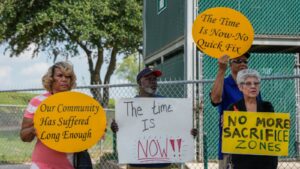Easter Island has long been held up as a prime example of people undermining their own survival by destroying the environment they rely on. But now fresh data is turning the narrative on its head.
Also known as Rapa Nui, the remote island in Polynesia is famous for its large stone statues called “moai” and for the idea that its growing population collapsed due to “ecocide”.
The theory – promoted by experts including Pulitzer Prize-winning author Jared Diamond – suggest that islanders cut down palm trees at an unsustainable rate to create gardens, harvest fuel and move statues, causing disaster. As a result, the population that Europeans encountered in the 18th century was a shadow of what it once was.
However, a new study added a growing body of evidence that offers a very different view.
“Our study confirms that the island could not have supported more than a few thousand people,” said Dr. Dylan Davis, a co-author of the work from Columbia University. “As such, contrary to the ecocide narrative, the population present upon European arrival was not the remnants of Rapa Nui society, but was probably the society at its peak, living at the levels that were sustainable on the island .”
Write in the journal Science AdvancesDavis and colleagues reported how they harnessed high-resolution shortwave infrared and near-infrared satellite imagery and machine learning to identify archaeological sites of rock gardening—a practice used by Easter Islanders to grow crops, including sweet potatoes.
The results indicate only 0.76 km2 soil was used in this way – well below previous estimates which, the team said, were mistakenly identified as natural lava flows.
As a result, Davis and colleagues suggested that rock gardening alone could have supported only about 3,900 people at most, a long way from previous estimates of up to 17,000. Indeed, the average figure is only 2,000 people, although up to 4 000 people can be increased if other sources, for example from fishing or foraging, are taken into account.
“One of the main arguments for an ‘ecocide’ was that the population must have been very large to build all the moai statues,” Davis said.
“However, archaeological evidence does not support a large population and studies of the moai themselves suggest that a small population could have built and moved them. It just required cooperation.”
Davis added that while the first humans to arrive on Rapa Nui in about 1200-1250 AD found an island covered in forests but with limited soil nutrients, it was the arrival of the seed-eating Polynesian rat that left the tree population decreased.
“When Europeans arrived in the 18th century, they found a society living within their means and growing much of their food in rock gardens in an otherwise unbuildable landscape,” he said.
Prof Sue Hamilton, an expert on Rapa Nui from University College London who was not involved in the work, said the study was not the first to question earlier ideas.
She said: “For at least a decade, the idea of ecocide through population growth and landscape mismanagement has been increasingly convincingly challenged for Rapa Nui.”
But while Hamilton called the new work “ingenious,” she said it had limitations — some of which the authors acknowledged — including that it was not possible to prove that population size could be extrapolated from the extent of rock gardening. , and that the rock gardens can date from different times. She also argued that some rock gardening sites were overlooked.
“The situation is simply more complex than this one field of study alone can solve,” Hamilton said.




